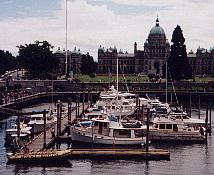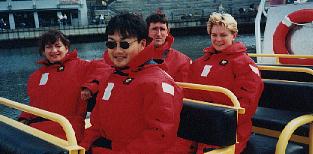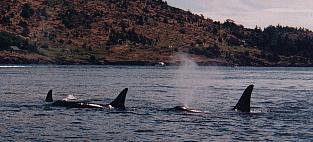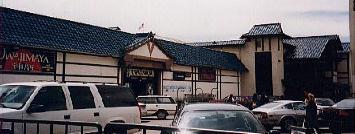Cascadia
A Tour of Cascadia
June 1997
-
Victoria: I visited the Royal British Columbia Museum.
They have great standing exhibits which chronicle the history of British Columbia and
show that the west coast's status as a site of international commerce is far from new.
The current special exhibit is
"Whales: The Enduring Legacy",
which mostly deals with the history of whaling on the west coast.
I was impressed by how an entire industry could be shut down, almost overnight.
 Inspired, I signed up for a whale watching tour.
The tours leave from Victoria's Inner Harbour,
right in front of the Empress Hotel and provincial parliament building.
The mode of transportation is a zodiac -- can you spot it in the picture?
Inspired, I signed up for a whale watching tour.
The tours leave from Victoria's Inner Harbour,
right in front of the Empress Hotel and provincial parliament building.
The mode of transportation is a zodiac -- can you spot it in the picture?
The weather was sunny and the ocean was calm, but we all had to wear special exposure suits. We looked like an astronaut crew! A bystander shouted, "What time is liftoff?" My fellow whalewatchers were a family from Atlanta GA, and two couples from Holland.

The whales are a resident pod and have well-established feeding habits. Our guide found them without much trouble just off San Juan Island.

They were fairly business-like, just circling around, feeding. No SeaWorld jumps today! - Nanaimo: Before I left on this trip, I told an older nisei
(second-generation Japanese Canadian)
living in Toronto that I was going to Nanaimo for a friend's wedding.
"Nanaimo's beautiful. You might see my house," he said quietly.
"Oh," I blurted, "do you have a cottage out there?"
Then I realized he was among the Nikkei-jin (people of Japanese heritage) who after Japan's World War II attack on Pearl Harbor were rounded up and sent to makeshift internment camps in the interior of mainland British Columbia. Their homes and other property were seized and auctioned off by the Canadian government to defray the expense of their internment.
The Canadian government did not allow interned Japanese Canadians to return to the West Coast until 1949, well after the end of the War. By that time most had decided to resettle elsewhere, such as Manitoba, Ontario and Montreal.
- Seattle: I took a ferry to Vancouver, then rode a bus south to visit
my sister.
She showed me the International District, where
Uwajimaya is located.

Uwajimaya was at the centre of Seattle's nikkei community in pre-War times. After the uprooting of the Internment the community is gone, but Uwajimaya is still there today. It's mostly a supermarket for Japanese food (Safeway-sized -- the biggest I've seen outside of Japan), but they also sell Japanese gifts and dishes. Kinokuniya Bookstores has a branch here. I picked up a useful book, Common Japanese Phrases, the latest in Sanseido's excellent "Power Japanese" series. Interestingly, it is translated from the 1992 Japanese bestseller Kimari Monku no Jiten (Dictionary of Common Phrases)". In Japan, there is an expected behaviour for every situation, and books to tell you what to do! - Vancouver: My favourite Canadian city, but after a decade of unchecked growth it's getting choked by traffic and pollution. I was able to catch up with some friends from medical school and residency who live here now.
[Back to TOP]
View my guestbook | Sign my guestbook
 visitors since 22 June 1998
visitors since 22 June 1998